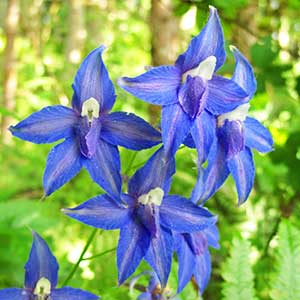Delphinium trolliifolium
Delphinium bakeri
Columbian larkspur, cow-poison, poison delphinium, poison larkspur
Baker's delphinium, Baker's larkspur
(40-)60-120(-180) cm;
base usually reddish, glabrous to puberulent.
(45-)60-85(-100) cm;
base reddish, glabrous.
blade ± pentagonal, 4-8 × 7-16 cm, margins ± incised, nearly glabrous; ultimate lobes 0-9, width 15-30 mm (basal), 5-20 mm (cauline), widest at middle or in proximal 1/2.
blade pentagonal to round, 1-6 × 1.5-8 cm, margins crenate, glabrous; ultimate lobes 3-5, width 2-5 mm (basal), 5-30 mm (cauline), widest at middle or in proximal 1/2.
(5-)14-40(-75)-flowered, ± open, at least 2 times longer than wide;
pedicel 1-4(-9) cm, puberulent to glabrous;
bracteoles (2-)6-12 mm from flowers, green, linear, 5-9(-14) mm, puberulent.
8-23-flowered, at least 2 times longer than wide;
pedicel 1-6(-9) cm, glandular-puberulent;
bracteoles 4-6 mm from flowers, green to blue, lance-linear, 5-8(-13) mm, glabrous to glandular-puberulent.
sepals dark blue, glabrous, lateral sepals spreading, (8-)14-21 × 5-9 mm, spurs straight or downcurved at apex, within 20° of horizontal, (10-)16-23 mm;
lower petal blades covering stamens, 5-10 mm, clefts 1.5-3 mm;
hairs sparse, mostly near junction of blade and claw, centered or on inner lobes, well dispersed, yellow.
sepals dark bluish purple, nearly glabrous, lateral sepals spreading, 9-11 × 4-5 mm, spur apex decurved, ± horizontal, 9-13 mm;
lower petal blades ± covering stamens, 5-7 mm, clefts 2-3 mm;
hairs sparse, mostly near base of cleft, centered or on inner lobes, white.
(15-)23-34 mm, 3.8-5.5 times longer than wide, glabrous.
18-20 mm, 3.5-4 times longer than wide, glabrous.
unwinged;
seed coats smooth.
unwinged;
seed coats smooth.
= 16.
Delphinium trolliifolium
Delphinium bakeri
Delphinium trolliifolium occurs in the northern Coast Range of California, the Columbia River Valley to just east of Mt. Hood, and the Willamette Valley of Oregon upstream to Lane County. California plants differ somewhat from Oregon plants in pubescence patterns and habitat preferences. Further study may show that two entities are involved here.
Hybrids between Delphinium trolliifolium and D. decorum, D. menziesii subsp. pallidum (D. ×pavonaceum Ewan, Peacock larkspur), D. nudicaule, D. nuttallianum, and D. nuttallii are known. Delphinium trolliifolium is likely to be confused only with D. bakeri. Refer to discussion under that species for differences.
(Discussion copyrighted by Flora of North America; reprinted with permission.)
Of conservation concern.
Delphinium bakeri is possibly extinct in the wild because of cultivation and sheep grazing in the small area where it grows. It is known from only two localities and has not been collected since 1960. Plants have been grown at Strybing Arboretum, Golden Gate Park, San Francisco. Although their geographic ranges are distinct, D. bakeri is most similar to, and probably closely related to, D. trolliifolium. The former has more rounded incisions on the leaves than the latter, and the pedicel of D. bakeri are consistently glandular. Glandular pedicel appear only occasionally in D. trolliifolium.
(Discussion copyrighted by Flora of North America; reprinted with permission.)


